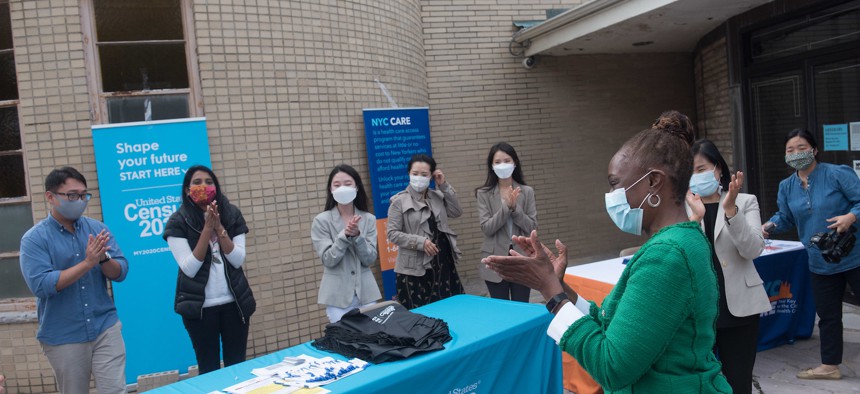New York State
An early end to the census compounds fears of political manipulation
Stopping the count could lead to an inaccurate tally and a loss of congressional representation for New York.

NYC First Lady Chirlane McCray visiting NYC Care, U.S. Census and Covid-19 outreach workers at Korean Community Services Community Center in Queens. Michael Appleton/Mayoral Photography Office
The U.S. Supreme Court on Tuesday sided with the Trump administration and will allow the 2020 census to be ended early, which means the decennial count will not be accepting responses beginning on Friday. Advocates who pursued litigation to keep the census going through the end of October said that a shortened timeline would lead to a greater undercount of the population.
The ruling could open the door to the political manipulation of census data by the Trump administration – which would have dire implications for New York, since the state is already at risk of losing at least one congressional seat.
“President Trump now is going to be in office in December, whether or not he wins or loses the election,” Julie Menin, who has been leading New York City’s census initiatives, said on Wednesday. “That means that he and his administration are basically in charge of the data, they’re in charge of the census data, they’re in charge of how those decisions are going to be utilized for congressional apportionment.”
President Donald Trump has complicated the typically nonpartisan count throughout his time in office. He unsuccessfully attempted to add a citizenship question to the census in 2018, which immigration advocates said was meant to intimidate undocumented immigrants into not filling out the forms. He is also trying to exclude undocumented immigrants from the population totals used to determine how many congressional seats are apportioned to each state, which experts said was likely unconstitutional. The 14th Amendment states that representatives will be apportioned by “counting the whole number of persons in each state,” which has largely been interpreted to refer to every single person living in the state regardless of their immigration status.
During the early stages of the census count this year, many efforts to encourage participation were derailed by the coronavirus pandemic and the ensuing lockdowns. The U.S. Census Bureau created a new timeline that extended the count to the end of October in order to allow people extra time to respond to the census and to send workers to follow up with people who hadn’t responded. But by the end of July, the agency abruptly decided to end the count a month early.
An inquiry from the inspector general’s office at the Commerce Department, which oversees the Census Bureau, found that the decision was not prompted by census officials and reported that some inside the agency felt pressured by the Commerce Department to complete door-knocking efforts sooner.
Trump administration officials argued that the shortened count was needed in order to meet a Dec. 31 legal deadline to deliver state population totals to the president for the purpose of allocating congressional seats. Democrats in the House of Representatives passed legislation that would extend the deadline by four months, but Senate Republicans haven’t acted on it.
Sticking to the Dec. 31 timeline means that Trump would have oversight of the state population totals and how they are used to allocate congressional districts. Fears that the president may manipulate the data for his political advantage have abounded, particularly after Commerce Secretary Wilbur Ross told NPR earlier this month that “the president has the ability to do all kinds of modifications to the material that we send in.” The rushed schedule also would likely mean an inaccurate count, as census officials themselves have warned since May that they could not meet the deadline for delivering the data.
The Census Bureau could blow past its legal deadline. But if it succumbs to pressure to meet the timeline, it would likely send inaccurate data. Assuming the U.S. Supreme Court sides with Trump or the case remains pending, Trump could also implement his plans to exclude undocumented immigrations for the purposes of congressional reapportionment. That would also lead to further inaccuracies. Because the census didn’t ask a citizenship question, the federal government would subtract the estimated population of undocumented immigrants. Although one analysis from the Pew Research Center showed the order’s impact would mostly hurt California, Florida and Texas, it would still hurt New York, which has a comparatively large population of undocumented immigrants. About 725,000 immigrants who entered the country illegally were estimated to live in the state in 2016, according to the Pew Research Center, out of New York’s population of more than 19 million.
A severe undercount could lead to litigation which may further complicate matters, though historically the courts have tended to side with the Census Bureau.
“Once the count is over, obviously we have to carefully look at the data to determine what our options are and we will aggressively pursue any legal option should we feel that New York City was undercounted,” Menin said.
Hypothetically, the inaccurate data could also be blocked by the Democrat-led House of Representatives. The Commerce Department has to send the state population totals to the president, who must then send that information to the House for approval.
That led Jeffrey Wice, an expert in the census and redistricting at New York Law School, to ask during an Oct. 2 webinar: “If those numbers are adjusted, if they’re modified, if there’s any way they’re distorted, will the House certify the data?”

